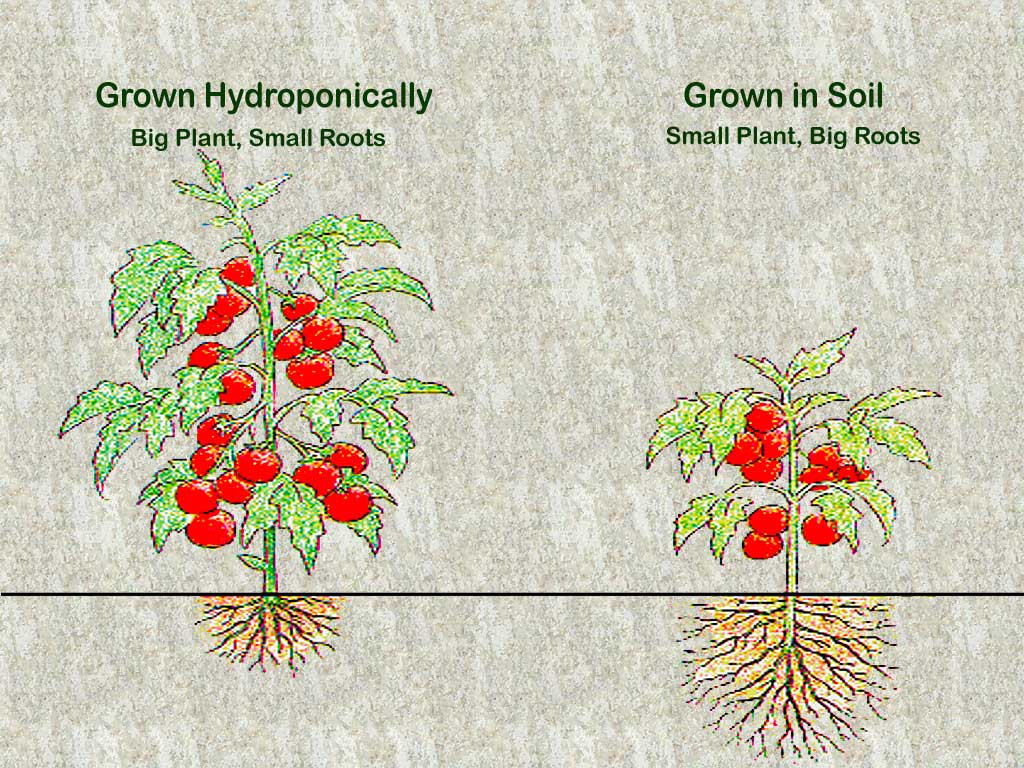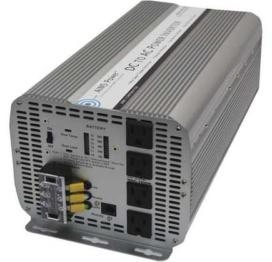
Soil versus Hydroponics
| Growing in Soil | Growing Hydroponically | |
| Soil microorganisms are necessary to break down soil particles into the basic elements of nitrogen, phosphorus, potassium and trace elements.. | Balanced nutrient formula is dissolved directly into water so plants receive perfect nutrition at all times. | |
| There is a lower concentration of nutrients in soil so roots must grow longer to search for all the nutrients the plant needs. | Hydroponic systems deliver the appropriate amount of nutrients directly to the root zone; plant roots can stay smaller and more compact. | |
| Soil loses its nutritional value and it’s difficult to measure its pH and nutritional content. | The pH and nutritional value of the water are easily measured and maintained, so plants always have enough nutrition to photosynthesize. | |
| The basic elements need to be dissolved in water so plant roots can absorb them; water is not always available in soil. | Water is present for most or all of the time, so roots can always absorb nutrients. | |
| Soil is a host for many pests and diseases that can harm plants. | Hydroponics growing mediums are inert and sterile which means the environment is very hygienic, which reduces the occurrence of pests and disease. | |
| Soil requires a lot of watering; plants grow slower, more space and constant maintenance are necessary. | Hydroponics increases plant growth and yield per area and decreases watering and maintenance. |
Growing plants with hydroponics is fundamentally different from growing plants in soil. One is not necessarily better than the other; the location and personal preferences of the person doing the growing often dictates which method to use. Hydroponics is often used for growing food in smaller spaces, because it allows us to utilize vertical space more than soil does. If someone has a big space with fertile soil, then using the soil may be better for that situation. Here are some of the differences between the two methods.
When growing in the ground, the soil must be fertile, or have lots of nutrients in it. Soil must be amended, which means either adding rich compost or fertilizer, in order to grow healthy plants. Soil organisms, such as earthworms, bacteria, and microorganisms, break down these soil particles into the basic elements that plants can use. These elements include nitrogen, phosphorus, and potassium, among others.
If soil is not properly amended, there will be a lower concentration of nutrients in the soil. In addition, these nutrients must be dissolved in water for the roots to be able to uptake them. If water is not available because of drought or poor, sandy soil, plants will wilt, and they will not have enough nutrients to grow properly. Plants need to expend energy so the roots can grow until they find the nutrients or water that they need. Root systems in soil tend to be larger because of this.
Hydroponics uses no soil; instead it uses a completely inert, sterile medium. Nutrients in their elemental form are added to the water, and plants are usually watered several times throughout the day. Plant roots absorb these nutrients directly because they are already in their most basic form and dissolved in water. It is simple to test the nutrient solution to find out what concentration of nutrients is available to the plant roots. It is very easy to add nutrients if the plants need more. This way, the plant’s energy can go into creating more of the plant above the soil (the portion we usually like to eat). Hydroponic plants tend to be larger than those grown in soil, with smaller root systems.
The pH of the growing media is very important because there is an ideal range at which plants can absorb the necessary nutrients. If the pH of the media is too acidic or too alkaline, the plant will be unable to absorb certain elements, which may result in a nutrient deficiency. When plants are stressed due to a nutrient deficiency, it’s more likely that pests and disease will become a problem.
Soil pH is difficult to control, and can vary based on whatever is in the soil near where you are growing. For example, if the garden is located in an area rich with limestone, the soil will have a very high pH- too high for plants to grow. The soil will always naturally go back to that high pH unless you regularly make an effort to lower it. PH is just as important in hydroponics, but it is easier to control. Starting with an inert media means that the media’s pH is close to neutral. The source of the water must be taken into consideration, for more information on this, read our article Types of Water in a Hydroponic System. It is easier to test the pH of nutrient solution than it is to test the pH of soil, and tests that use water are usually more accurate and easy to use than those that test soil.
The amount of maintenance required is important to consider before starting a garden, either hydroponic or soil. Soil gardens must be watered regularly, or an irrigation system must be installed. The time spent watering can add up, and it’s easy to forget to water your garden every day. On the contrary, if plants are provided with too much water, such as from a big rainstorm, plants can drown if there is not sufficient drainage. After a hydroponic system is set up with a timer, no watering is required! You’ll need to check on it every so often to make sure the pump turns on and off when it is supposed to, but it basically waters itself.
Soil gardens require soil amendments, which often means lugging heavy bags or wheelbarrows full of compost and spreading it around, only to find out that weeds enjoy the rich soil as well. There are virtually no weeds in a hydroponic garden, because the media is inert- which means it contains no weed seeds! The only weeds that come in will be from the wind or a bird, which will always be fewer weeds than in a soil garden. In addition, vertical gardens make for much easier harvests. You can harvest at eye level, instead of crouching down on your hands and knees.
There are many differences between soil and hydroponics, and its up to you to decide which would be best for the space you have available, the amount of time you have to dedicate to it, as well as your lifestyle.

Hydroponic Nutrients

EC vs TDS

Organic Does Not Mean “No Pesticides”

How Plants Uptake Nutrients

What is Aquaponics
Trackbacks and pingbacks
No trackback or pingback available for this article.
Articles
Featured
-
 EzGro Patio GardenRegular Price $389.99 – $399.99
EzGro Patio GardenRegular Price $389.99 – $399.99 -
 EzGro Quad Pot 50 PackRegular Price $499.90
EzGro Quad Pot 50 PackRegular Price $499.90 -
 Outdoor 3 Outlet Smart Plug TimerRegular Price $39.99
Outdoor 3 Outlet Smart Plug TimerRegular Price $39.99 -
 EzGro Precision Micro TrimmerRegular Price $11.99
EzGro Precision Micro TrimmerRegular Price $11.99 -
 Five Tower Strawberry GardenRegular Price $2,799.00
Five Tower Strawberry GardenRegular Price $2,799.00 -
 5000 Watt 48 Volt Power InverterRegular Price $899.00
5000 Watt 48 Volt Power InverterRegular Price $899.00 -
 Drain Dish & Diffuser Dish SetRegular Price $16.99
Drain Dish & Diffuser Dish SetRegular Price $16.99 -
 Tri-Helix Solar WindmillRegular Price $4,399.00
Tri-Helix Solar WindmillRegular Price $4,399.00 -
 Thermoplastic Irrigation Pump 1 HPRegular Price $469.99
Thermoplastic Irrigation Pump 1 HPRegular Price $469.99 -
 EzGro Quad Pot 25 PackRegular Price $274.99
EzGro Quad Pot 25 PackRegular Price $274.99









Leave a reply